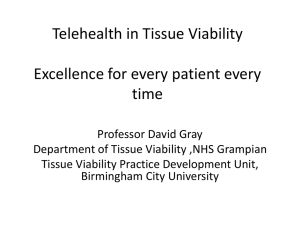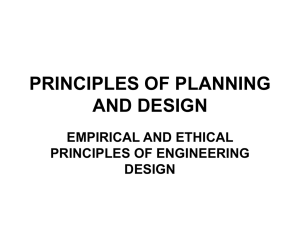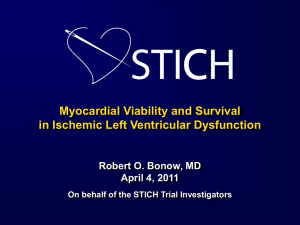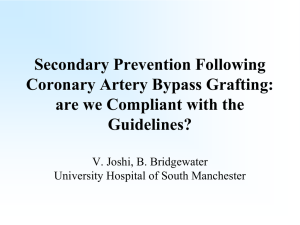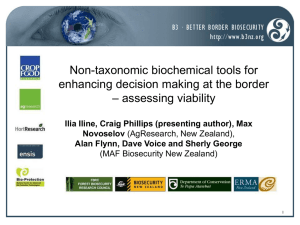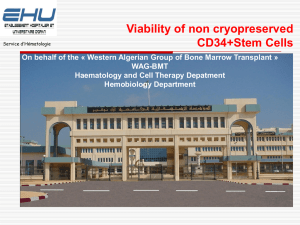STICH Viability Hypothesis
advertisement
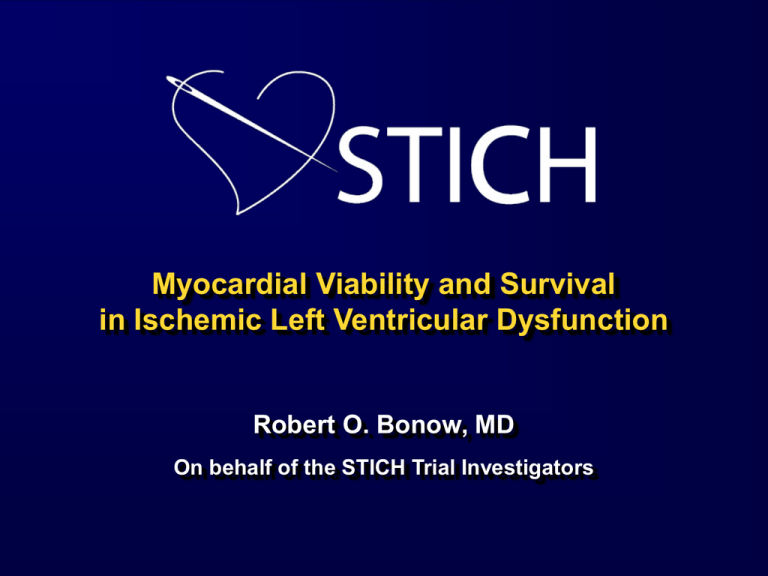
Myocardial Viability and Survival in Ischemic Left Ventricular Dysfunction Robert O. Bonow, MD On behalf of the STICH Trial Investigators STICH Financial Disclosures Original Recipient Institution Principal Investigator Activity Duke University Medical Center Robert H. Jones Clinical Coordinating Ctr Duke University Medical Center Kerry L. Lee Statistical and Data CC Northwestern University Robert O. Bonow Radionuclide Core Lab Washington Hospital Center Julio A. Panza Dobutamine Echo Core Mayo Clinic Jae K. Oh Echo Core Laboratory Univ of Alabama-Birmingham Gerald M. Pohost CMR Core Laboratory University of Pittsburgh Arthur M. Feldman NCG Core Laboratory Baylor University Medical Ctr Paul Grayburn MR TEE Substudy Duke University Medical Center Daniel B. Mark EQOL Core Laboratory Funding Sources: National Heart, Lung and Blood Institute 98% Abbott Laboratories 2% Background • LV dysfunction in patients with CAD is not always an irreversible process, as LV function may improve substantially after CABG • Assessment of myocardial viability is often used to predict improvement in LV function after CABG and thus select patients for CABG • Numerous studies have suggested that identification of viable myocardium also predicts improved survival after CABG Limitations of Cohort Studies • Decision for CABG may have been influenced by viability status • No (or inadequate) adjustment for key baseline variables (age, comorbidities) • Cohort studies carried out before modern aggressive medical therapy STICH Revascularization Hypothesis • The first prospective randomized trial testing the hypothesis that CABG improves survival in patients with ischemic LV dysfunction compared to outcome with aggressive medical therapy • Provides the first opportunity to assess the interaction between myocardial viability and survival in randomized patients who were all eligible for medical management alone and also eligible for CABG. STICH Viability Hypothesis In this prospective substudy, we tested the hypothesis that assessment of myocardial viability identifies patients with CAD and LV dysfunction who have the greatest survival benefit with CABG compared to aggressive medical therapy STICH Viability Hypothesis • All randomized patients were eligible for viability testing with SPECT myocardial perfusion imaging or dobutamine echo. • Viability testing was optional at enrolling sites and was not a prerequisite for enrollment. STICH Viability Hypothesis SPECT protocols: • Thallium-201 stress-redistribution-reinjection • Thallium-201 rest-redistribution • Nitrate-enhanced Tc-99m perfusion imaging Dobutamine echo protocols: • Staged increase in dobutamine starting at 5 μg/kg/min STICH Viability Hypothesis Criteria for myocardial viability were prospective and pre-specified SPECT: • 17 segment model • ≥11 segments manifesting viability based on relative tracer activity Dobutamine echo: • 16 segment model • ≥5 segments with dysfunction at rest manifesting contractile reserve with dobutamine STICH Viability Hypothesis Primary endpoint: ▪ All-cause mortality Secondary endpoints: ▪ Mortality plus cardiovascular hospitalization ▪ Cardiovascular mortality Intention-to-treat analysis Patients randomized in STICH Revascularization Hypothesis 1212 Patients with myocardial viability test 618 611 Patients with no usable myocardial viability test Unusable test • Timing • Poor quality 17 Patients with usable myocardial viability test 594 Patients with no myocardial viability test 601 Patients randomized in STICH Revascularization Hypothesis 1212 SPECT n=471 Dobutamine echo n=280 321 150 130 611 Patients with usable myocardial viability test 601 114 487 Viable Nonviable Patients with no usable myocardial viability test Baseline Characteristics Patients With and Without Myocardial Viability Variable Viable (n=487) Non-Viable (n=114) P value Age 61 ± 10 61 ± 9 NS Multivessel CAD 73% 73% NS Proximal LAD stenosis 64% 70% NS Risk score * 12.4 ± 8.7 12.9 ± 9.3 NS Previous MI 76.6% 94.7% <0.001 LV ejection fraction (percent) 28 ± 8 23 ± 9 <0.001 LV end-diastolic volume index (ml/m2) 117 ± 37 147 ± 53 <0.001 LV end-systolic volume index (ml/m2) 86 ± 33 116 ± 50 <0.001 * Significant covariates in risk model: Age, renal function, heart failure, ejection fraction, CAD index, mitral regurgitation, stroke Myocardial Viability and Mortality 1.0 Without viability Variables associated with mortality With viability Mortality Rate 0.8 HR 0.64 95% CI P 0.48,0.86 0.003 0.6 Risk score LV ejection fraction LV EDVI LV ESVI Myocardial viability Chi-square p 33.26 24.80 35.36 33.90 8.54 <0.001 <0.001 <0.001 <0.001 0.003 50% 0.4 33% 0.2 0.0 Without viability With viability 0 1 114 487 99 432 2 3 4 Years from Randomization 85 409 80 371 63 294 5 6 36 188 16 102 Myocardial Viability and Mortality Variable No. Univariate Chi-square p value Multivariable Chi-square p value SPECT and/or DE 601 8.54 0.003 1.57 0.210 SPECT alone 471 7.35 0.007 0.58 0.444 DE alone 280 1.18 0.277 0.42 0.518 Myocardial Viability and Cardiovascular Mortality 1.0 Without viability Cardiovascular Mortality Rate With viability Univariate 0.8 HR 0.61 95% CI P 0.44,0.84 0.003 Chi-square p value 8.81 0.003 Multivariable Chi-square p value 0.91 0.339 0.6 43% 0.4 29% 0.2 0.0 Without viability With viability 0 1 114 487 99 432 2 3 4 Years from Randomization 85 409 80 371 63 294 5 6 36 188 16 102 Myocardial Viability and Mortality + CV Hospitalization Mortality and CV Hospitalization Rate 1.0 Without viability 82% With viability 0.8 HR 0.59 95% CI P 0.47,0.74 0.001 0.6 63% 0.4 Univariate Multivariable HR 95% CI P Chi-square p value Chi-square<0.001 p value 0.59 0.47,0.44 0.2 20.27 <0.001 8.60 0.003 5 6 14 94 5 41 0.0 Without viability With viability 0 1 114 487 56 327 2 3 4 Years from Randomization 41 284 34 238 22 166 Patients with viability tests 601 Patients with myocardial viability 487 Patients without myocardial viability 114 243 244 60 54 MED 49.9% CABG 50.1% MED 52.6% CABG 47.4% Baseline Characteristics Viable (n=487) Non-Viable (n=114) Variable MED (n=243) CABG Variable P value (n=244) MED (n=60) CABG (n=54) P value Age 60 ± 10 62 ± Age 9 62 ± 9 60 ± 9 NS NS Gender (% male) 84% 86%Gender (% NS male) 92% 93% NS Previous MI 78% 75%Previous MINS 93% 96% NS Multivessel CAD 72% 73%MultivesselNS CAD 68% 78% NS Proximal LAD 65% 63%Proximal LAD NS 70% 70% NS 13.7 ± 9.8 12.9 ± 9.3 NS Risk score * 11.9 ± 8.4 12.8 ± Risk 903 score NS * LV EF (percent) 28 ± 8 27± LV 8 EF (percent) NS 23 ± 9 23 ± 9 NS LV EDVI (ml/m2) 118 ± 38 116 ±LV 35 EDVI (ml/m NS 2) 151 ± 51 140 ± 54 NS LV ESVI (ml/m2) 86 ± 34 86 ±LV 32ESVI (ml/m NS 2) 121 ± 50 111 ± 51 NS * Significant covariates in risk model: Age, renal function, heart failure, ejection fraction, CAD index, MR, stroke Myocardial Viability and Mortality Without Viability 1.0 Mortality Rate 0.8 With Viability MED (33 deaths) MED (95 deaths) CABG (25 deaths) CABG (83 deaths) 56% 0.6 35% 0.4 42% 31% 0.2 0.0 0 1 2 3 4 5 Years from Randomization MED 60 51 44 39 29 CABG 54 48 41 41 34 6 0 1 2 3 4 5 Years from Randomization 6 14 4 243 219 206 179 146 94 51 22 12 244 213 203 192 148 94 51 Myocardial Viability and Mortality Without Viability 1.0 Mortality Rate 0.8 With Viability MED (33 deaths) MED (95 deaths) CABG (25 deaths) CABG (83 deaths) 56% 0.6 35% 0.4 42% 31% 0.2 0.0 0 1 2 3 4 5 Years from Randomization 6 0 1 2 3 4 5 Years from Randomization Subgroup N Deaths HR 95% CI Interaction P value Without viability 114 58 0.70 0.41, 1.18 0.528 With viability 487 178 0.86 0.64, 1.16 0.25 0.5 CABG better 1 2 MED better 6 Interaction of Viability and Treatment on CV Outcomes Endpoint Mortality Mortality or CV hospitalization CV mortality Events Treatment 236 422 187 p value As randomized 0.528 As treated 0.962 As randomized 0.390 As treated 0.975 As randomized 0.697 As treated 0.261 STICH Viability Hypothesis Limitations: • Lack of viability data in all patients; patients represent a subpopulation of STICH • Analysis limited to SPECT and dobutamine echo, not PET or cardiac MRI STICH Viability Hypothesis • STICH represents the largest report to date relating myocardial viability to clinical outcomes of patients with CAD and LV dysfunction • … and is the first to assess these relationships prospectively among patients who were all eligible for CABG as well as optimal medical management alone STICH Viability Hypothesis STICH results: …demonstrate a significant association between myocardial viability and outcome, but this association is rendered non-significant when subjected to a multivariable analysis that includes other prognostic variables. …fail to demonstrate a significant interaction between myocardial viability and medical versus surgical treatment with respect to mortality, whether assessed according to treatment assigned (intention to treat) or to the treatment actually received. STICH Viability Hypothesis Implications: In patients with CAD and LV dysfunction, assessment of myocardial viability does not identify patients who will have the greatest survival benefit from adding CABG to aggressive medical therapy Full report available at www.NEJM.org
